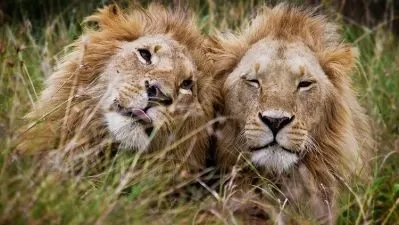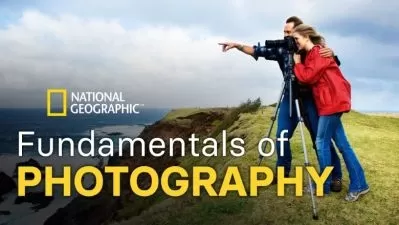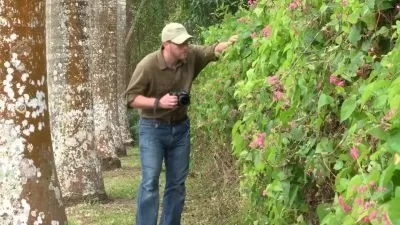Field Guide to North American Wildlife
David Mizejewski
5:37:08
Description
Wildlife is all around us in North America: in the air, on land, underwater. Not only are these animals astounding and fascinating to see, but they’re also more important to our survival than most of us realize.
There’s a fantastic array of native mammals, birds, reptiles, amphibians, fish, and invertebrates that populate the North American continent. Consider:
- Wild Native Bees, of which there are approximately 4,000 species that have existed in North America for millennia;
- American Alligators, whose bite is the force equivalent of the weight of two concert grand pianos; or
- Wild Salmon, who travel as far as 1,800 miles up North American streams to spawn.
And those are just three of the many remarkable species out there. Some of them you may not know as well as you think you do, and others you’ve probably never heard of. All of them play an important role in our ecosystem. As human activity takes a heavy toll on the natural ecosystems we depend on, it’s more important than ever to understand native species and why their survival is so imperative.
In Field Guide to North American Wildlife, join author and television host David Mizejewski, a naturalist with the National Wildlife Federation, for a fascinating 12-lecture course that focuses on 12 wild animals found throughout North America. You’ll meet a two-foot-long salamander that breathes through its skin. You’ll follow a single monarch butterfly on its astounding 3,000-mile journey from southern Canada to central Mexico. You’ll discover how black bears may offer key insights into human health, and so much more. This course is a chance to experience the beauty and wonder of these incredible animals and to learn why safeguarding their future is so crucial to our own.
Incredible Insights into Incredible Animals
Your experience of Field Guide to North American Wildlife will be like a virtual zoo that you can tour at your leisure. The 12 fascinating animals featured in this course reveal great insights into the animal kingdom that will have you appreciating these animals in entirely new ways. A few of the species you’ll meet include:
- Monarch Butterflies: In most cases, the monarch butterfly only lives in its adult butterfly form for a few weeks, just long enough to complete the reproductive process. The generation of monarchs that migrates, however, is an important exception to this rule. These monarchs live some eight times as long as the generation that preceded theirs. And as small and delicate as they are, they’re strong enough to fly from southern Canada all the way to their wintering grounds in Mexico.
- Leatherback Sea Turtles: These turtles can maintain a body temperature of around 79 degrees Fahrenheit despite the conditions around them—something no other living reptile can do. How? Rather than generating heat metabolically via internal core body functions, leatherbacks generate it kinetically through the constant pumping of the muscles that power their massive flippers. Because of this, some leatherbacks can even be found north of the Arctic Circle.
- Screech Owls: One way to spot these tiny, elusive owls is to look for mobbing songbirds. When a group of songbirds locates a screech owl (or any owl, for that matter), they’ll gather all around it, alarm calling and swooping close to the owl. When songbirds mob like this, they’re trying to scare off a potential ambush predator by letting it know that its cover has been blown. Screech owls, however, tend to be indifferent to these mobs if they aren’t actively hunting.
- Salamanders: An underappreciated group of animals, salamanders are actually some of the most common and numerous types of vertebrate wildlife in many of our ecosystems. In fact, if you added up the biomass from salamanders in many eastern forests, it would equal the biomass of all the other vertebrate wildlife of all species living in that forest. So why are salamanders so infrequently seen by most people? Because they live in places out of sight to us, including underwater—like where the giant hellbender salamander lives.
Wild Tales of Struggle and Survival
David can tell you plenty about these animals (and does), but what makes Field Guide to North American Wildlife such a fascinating learning experience is that he also gives you a sense of what it’s like to be one of these wild animals.
A powerful way to help people appreciate wild animals, and the challenges they often face in coexisting with us, is to show people what the world must look like through their eyes. Admittedly, we can’t know exactly what animals think and feel; but through the imaginative power of storytelling, we can learn their point of view about some of the things they experience.
Each lecture of the course includes a fictional story based on the real-life behavior of the animal species, explaining its behavior, habitat, and daily struggles for survival. Among the characters you will meet are:
- Chanifir is a red wolf who’s recently left her family pack and followed the impulse to find a mate and, with him, claim a territory and establish a new pack.
- Zenya is a blue orchard mason bee who flees her habitat in a brush pile and sets out gathering mud to build a nesting tunnel in an old log.
- Mauchy is a black bear who wanders through a New Jersey neighborhood in search of things to eat and finds himself face to face with humans.
- Taya is a javelina whose encounter with unleashed dogs illustrates how this incredible animal tries to defend itself from danger.
By the end of Field Guide to North American Wildlife, you’ll feel like you’ve finished an adventure into the wild. More than that, you’ll come away with a newfound appreciation of, and concern for, our planet and the many incredible varieties of life that step across its soils, swim through its rivers and seas, and soar along its breezes.
More details
User Reviews
Rating
David Mizejewski
Instructor's CoursesDavid Mizejewski is a naturalist with the National Wildlife Federation and the author of Attracting Birds, Butterflies, and Other Backyard Wildlife. He has appeared on shows such as The Martha Stewart Show, Conan, The Wendy Williams Show, and NBC’s TODAY, and he has hosted series on Animal Planet and Nat Geo WILD. He earned a BA in Human and Natural Ecology from Emory University.

The Great Courses
View courses The Great Courses- language english
- Training sessions 13
- duration 5:37:08
- English subtitles has
- Release Date 2024/02/02










